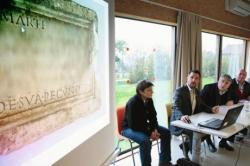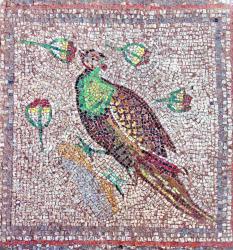INSTITUT SUPERIEUR D'ANTHROPOLOGIE
INSTITUTE OF ANTHROPOLOGY
ONLINE COURSES / COURS A DISTANCE
INSCRIPTION : Année Universitaire 2012/2013
REGISTRATION : Academic Year 2012 / 2013
FRANCE –  Chassenon - Les dernières campagnes de fouilles sur les thermes de Chassenon ont permis de faire des avancées spectaculaires sur la connaissance du site. Les fouilles ont permis d'identifier trois phases d'occupation différentes. La première est contemporaine du règne d'Auguste (- 25 avant J.-C. à l'An 1), avec la construction d'un premier bâtiment qui a été ensuite agrandi et complété par un petit espace balnéaire (IIe-IIIe siècle), « La question est de savoir si l'habitation était intégrée à l'agglomération antique où si elle était en dehors », notait Philippe Perrier. De nombreux éléments (céramique, monnaie…) ont également été trouvés sur place tout comme les traces de la présence d'un atelier de forge. Enfin, des sépultures et un four de verrier atteste d'une présence au Moyen Âge. « Reste à savoir si ces sépultures correspondent à la construction de l'église (XIe) et on serait là à la limite du cimetière médiéval. Ou alors elles sont antérieures et cela suppose qu'il y ait eu une église primitive. » Chassenon n'a pas fini de livrer ses secrets. Pépite de fouilles, la découverte, au début du mois lors d'un sondage, d'un bloc gravé d'inscriptions romaines de 70 cm de long et 50 cm de large. « En fait, il ne s'agit que d'une moitié du bloc total », précisait l'archéologue. Mais cette moitié suffit déjà à son bonheur. « On pensait que jamais on ne trouverait d'inscription sur ce site. Ce n'était jamais arrivé depuis les premières fouilles au XIXe siècle », se réjouissait l'archéologue. Si la fameuse plaque est pour le moment à l'étude pour déchiffrer au mieux ces inscriptions, le nom « Marti » permet d'ores et déjà d'affirmer que les thermes étaient bien associés à Mars, « qui n'était pas le dieu de la guerre, comme on le croit, mais un dieu protecteur des hommes », précisait David Hourcade. D'autres mots permettent de comprendre que cette plaque a été payée par les utilisateurs des thermes, « on peut en déduire qu'ils étaient riches ». Pour le reste, les études menées l'été dernier ont permis de glaner des nouvelles informations, tant sur la chronologie du lieu que sur l'organisation de l'espace des thermes. « On a pu établir une occupation du site au Ie siècle après J.-C., soit un siècle avant la construction des thermes. » Des thermes dont les entrées ont pu être établies sur les côtés sud et nord-est du bâtiment et qui donnaient sur un hall monumental de 2 000 m2, à partir duquel les gens faisaient leur parcours dans les thermes. « Alors que l'on pensait auparavant que l'entrée se faisait au centre de ce côté oriental et que l'on y accédait par un escalier, mais on n'avait jamais trouvé ni l'un ni l'autre, avant cette découverte. » La connaissance de Chassenon s'affine de fouilles en fouilles.
Chassenon - Les dernières campagnes de fouilles sur les thermes de Chassenon ont permis de faire des avancées spectaculaires sur la connaissance du site. Les fouilles ont permis d'identifier trois phases d'occupation différentes. La première est contemporaine du règne d'Auguste (- 25 avant J.-C. à l'An 1), avec la construction d'un premier bâtiment qui a été ensuite agrandi et complété par un petit espace balnéaire (IIe-IIIe siècle), « La question est de savoir si l'habitation était intégrée à l'agglomération antique où si elle était en dehors », notait Philippe Perrier. De nombreux éléments (céramique, monnaie…) ont également été trouvés sur place tout comme les traces de la présence d'un atelier de forge. Enfin, des sépultures et un four de verrier atteste d'une présence au Moyen Âge. « Reste à savoir si ces sépultures correspondent à la construction de l'église (XIe) et on serait là à la limite du cimetière médiéval. Ou alors elles sont antérieures et cela suppose qu'il y ait eu une église primitive. » Chassenon n'a pas fini de livrer ses secrets. Pépite de fouilles, la découverte, au début du mois lors d'un sondage, d'un bloc gravé d'inscriptions romaines de 70 cm de long et 50 cm de large. « En fait, il ne s'agit que d'une moitié du bloc total », précisait l'archéologue. Mais cette moitié suffit déjà à son bonheur. « On pensait que jamais on ne trouverait d'inscription sur ce site. Ce n'était jamais arrivé depuis les premières fouilles au XIXe siècle », se réjouissait l'archéologue. Si la fameuse plaque est pour le moment à l'étude pour déchiffrer au mieux ces inscriptions, le nom « Marti » permet d'ores et déjà d'affirmer que les thermes étaient bien associés à Mars, « qui n'était pas le dieu de la guerre, comme on le croit, mais un dieu protecteur des hommes », précisait David Hourcade. D'autres mots permettent de comprendre que cette plaque a été payée par les utilisateurs des thermes, « on peut en déduire qu'ils étaient riches ». Pour le reste, les études menées l'été dernier ont permis de glaner des nouvelles informations, tant sur la chronologie du lieu que sur l'organisation de l'espace des thermes. « On a pu établir une occupation du site au Ie siècle après J.-C., soit un siècle avant la construction des thermes. » Des thermes dont les entrées ont pu être établies sur les côtés sud et nord-est du bâtiment et qui donnaient sur un hall monumental de 2 000 m2, à partir duquel les gens faisaient leur parcours dans les thermes. « Alors que l'on pensait auparavant que l'entrée se faisait au centre de ce côté oriental et que l'on y accédait par un escalier, mais on n'avait jamais trouvé ni l'un ni l'autre, avant cette découverte. » La connaissance de Chassenon s'affine de fouilles en fouilles.
http://www.sudouest.fr/2012/10/20/un-site-dedie-a-mars-855525-813.php
TURQUIE – 
 – Izmir - A new ancient city considered to be the Zeugma of the West and thought to be one of the lost cities of Anatolia has been unearthed in İzmir. There are unique mosaics with figures in the city. Drilling work had started in the area, which is now categorized as a third degree archaeological site, before the construction of a warehouse company was scheduled to begin. Excavations were begun due to an abundance of signs the area may be a hotspot for archaeological treasures, Süslü said. “Scientific excavations started Oct. 1 and a layer from the 4th Century B.C. has been unearthed,” he said. The newly-unearthed city is believed to date back to around the late Roman or Byzantium period, Süslü said. It was home to a 550-square-meter villa complex with 105-centimeter-thick walls, water channels and 11 rooms. Precious mosaics were found in six of the villa complex’s rooms. “The mosaics are decorated with animal and plant figures that you cannot see anywhere today. They created the Anatolian panther, the Anatolian tiger as well as a partridge and a rabbit [in mosaics]. They are decorated with completely natural stones. You can see various shades of red, blue and green. There is a rich archaeological structuring in the region,” he said. According to Süslü, the historic structure in the city could be defined as the “Zeugma of the West,” but the most sorrowful thing was the illegal excavations. Zeugma is the ancient city known for its rich mosaics in the southeastern province of Gaziantep. Further, more detailed information about the name and estimated size of the newly-discovered city in İzmir would be given as a result of detailed excavation works.
– Izmir - A new ancient city considered to be the Zeugma of the West and thought to be one of the lost cities of Anatolia has been unearthed in İzmir. There are unique mosaics with figures in the city. Drilling work had started in the area, which is now categorized as a third degree archaeological site, before the construction of a warehouse company was scheduled to begin. Excavations were begun due to an abundance of signs the area may be a hotspot for archaeological treasures, Süslü said. “Scientific excavations started Oct. 1 and a layer from the 4th Century B.C. has been unearthed,” he said. The newly-unearthed city is believed to date back to around the late Roman or Byzantium period, Süslü said. It was home to a 550-square-meter villa complex with 105-centimeter-thick walls, water channels and 11 rooms. Precious mosaics were found in six of the villa complex’s rooms. “The mosaics are decorated with animal and plant figures that you cannot see anywhere today. They created the Anatolian panther, the Anatolian tiger as well as a partridge and a rabbit [in mosaics]. They are decorated with completely natural stones. You can see various shades of red, blue and green. There is a rich archaeological structuring in the region,” he said. According to Süslü, the historic structure in the city could be defined as the “Zeugma of the West,” but the most sorrowful thing was the illegal excavations. Zeugma is the ancient city known for its rich mosaics in the southeastern province of Gaziantep. Further, more detailed information about the name and estimated size of the newly-discovered city in İzmir would be given as a result of detailed excavation works.
http://www.hurriyetdailynews.com/izmir-presents-mosaic-city-of-western-region.aspx?pageID=238&nID=32979&NewsCatID=375
USA – Santa Barbara - Seventy years after it was scuttled off Los Angeles, government archaeologists have found the wrecked remains of the George E. Billings, a rare Pacific Coast schooner that was employed in the lumber trade during the early 1900s. Today at the California Islands Symposium in Ventura, Calif., Robert Schwemmer, maritime archaeologist for NOAA's Office of National Marine Sanctuaries, confirmed the ship's identity and presented a scientific paper on its history and discovery. The Billings, a five-masted schooner built in 1903 by Halls Bros. of Port Blakeley, Wash., was one of only six schooners of that type built on the Pacific Coast prior to 1905. The ship was built to haul lumber from the Northwest to Hawaii, Mexico, South America, Australia and southern California. After decades serving the lumber trade, it was converted into a sport-fishing barge. In 1941, the owner decided to scuttle the aging vessel off the coast of Santa Barbara Island, in waters now part of NOAA's Channel Islands National Marine Sanctuary.
http://www.edhat.com/site/tidbit.cfm?nid=102198